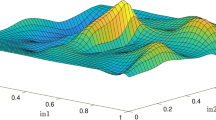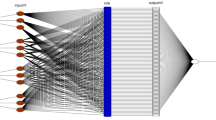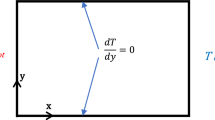Abstract
A nanofluid containing copper (Cu) nanoparticles was simulated in a rectangular cavity using computational fluid dynamic (CFD). The upper and lower walls of the cavity were adiabatic, while the right and left walls had warm and cold temperatures, respectively. This temperature difference causes a thermal flow from the right wall to the left wall. The elements of the coordination system in different directions, including velocity in the Y direction (V) and fluid temperature, were obtained using CFD. Adaptive network-based fuzzy inference system (ANFIS) was used to train the CFD outputs and provided artificial flow field and temperature distribution along the cavity domain. The CFD outputs were used as input and output data for the ANFIS method. The position of the fluid layer in X and Y computing directions and fluid velocity (Y axis) were used as three inputs, and the fluid temperature was taken as the output in the ANFIS method training process. The data were categorized using fuzzy c-means clustering, and different numbers of clusters were taken as a key parameter in this method. Using the fuzzy inference system, it is possible to predict the nodes in the cavity not generated through CFD simulation so that different coordination of the fluid at these points can be computed. Using ANFIS method, it is possible to reduce the computation time of CFD method so that more nodes are predicted in a shorter period of time, while clustering method can enhance the computing time for each neural cell. The ANFIS method can also visualize the flow in the cavity and display the thermal distribution along with the heat source.
Graphic abstract











Similar content being viewed by others
References
Abonyi J et al (1999) Inverse fuzzy-process-model based direct adaptive control. Math Comput Simul 51(1–2):119–132
Abu-Nada E (2008) Application of nanofluids for heat transfer enhancement of separated flows encountered in a backward facing step. Int J Heat Fluid Flow 29(1):242–249
Abu-Nada E (2009) Effects of variable viscosity and thermal conductivity of Al2O3–water nanofluid on heat transfer enhancement in natural convection. Int J Heat Fluid Flow 30(4):679–690
Aminossadati S, Kargar A, Ghasemi B (2012) Adaptive network-based fuzzy inference system analysis of mixed convection in a two-sided lid-driven cavity filled with a nanofluid. Int J Therm Sci 52:102–111
Asgarpour Khansary M et al (2017a) Correlation of sorption-induced swelling in polymeric films with reference to attenuated total reflectance Fourier-transform infrared spectroscopy data. Eur Polym J 91:429–435
Asgarpour Khansary M, Marjani A, Shirazian S (2017b) Prediction of carbon dioxide sorption in polymers for capture and storage feasibility analysis. Chem Eng Res Des 120:254–258
Asgarpour Khansary M et al (2018) A priority supposition for estimation of time-dependent changes in thickness and weight of polymeric flat sheet membranes fabricated by the nonsolvent induced phase separation (NIPS) technique. Adv Polym Technol 37(6):1963–1969
Avila G, Pacheco-Vega A (2009) Fuzzy-C-means-based classification of thermodynamic-property data: a critical assessment. Numer Heat Transf Part A Appl 56(11):880–896
Azwadi CSN et al (2013) Adaptive-network-based fuzzy inference system analysis to predict the temperature and flow fields in a lid-driven cavity. Numer Heat Transf Part A Appl 63(12):906–920
Babanezhad M et al (2019) Liquid‐phase chemical reactors: development of 3D hybrid model based on CFD‐adaptive network‐based fuzzy inference system. Can J Chem Eng 97(S1):1676–1684
Bararnia H, Soleimani S, Ganji DD (2011) Lattice Boltzmann simulation of natural convection around a horizontal elliptic cylinder inside a square enclosure. Int Commun Heat Mass Transf 38(10):1436–1442
Bataineh K, Naji M, Saqer M (2011) A comparison study between various fuzzy clustering algorithms. Jordan J Mech Ind Eng 5(4):335–343
Ben-Nakhi A, Mahmoud MA, Mahmoud AM (2008) Inter-model comparison of CFD and neural network analysis of natural convection heat transfer in a partitioned enclosure. Appl Math Model 32(9):1834–1847
Boyacioglu MA, Avci D (2010) An adaptive network-based fuzzy inference system (ANFIS) for the prediction of stock market return: the case of the Istanbul stock exchange. Expert Syst Appl 37(12):7908–7912
Brinkmann HC (1952) The viscosity of concentrated suspensions and solutions. J Chem Phys 20:571
Choi SU, Eastman JA (1995) Enhancing thermal conductivity of fluids with nanoparticles. Argonne National Lab, Lemont
Dashti A, Harami HR, Rezakazemi M (2018) Accurate prediction of solubility of gases within H2-selective nanocomposite membranes using committee machine intelligent system. Int J Hydrogen Energy 43(13):6614–6624
Daungthongsuk W, Wongwises S (2007) A critical review of convective heat transfer of nanofluids. Renew Sustain Energy Rev 11(5):797–817
Delavar MA, Farhadi M, Sedighi K (2010) Numerical simulation of direct methanol fuel cells using lattice Boltzmann method. Int J Hydrogen Energy 35(17):9306–9317
Ding Y et al (2018) Lattice Boltzmann method for rain-induced overland flow. J Hydrol 562:789–795
Fasihi M et al (2012) Computational fluid dynamics simulation of transport phenomena in ceramic membranes for SO2 separation. Math Comput Model 56(11):278–286
Fattahi E et al (2012) Lattice Boltzmann simulation of natural convection heat transfer in nanofluids. Int J Therm Sci 52:137–144
Ghadiri M, Shirazian S, Ashrafizadeh SN (2012) Mass transfer simulation of gold extraction in membrane extractors. Chem Eng Technol 35(12):2177–2182
Ghadiri M, Marjani A, Shirazian S (2013) Mathematical modeling and simulation of CO2 stripping from monoethanolamine solution using nano porous membrane contactors. Int J Greenh Gas Control 13:1–8
Ghasemi A et al (2017) Using quantum chemical modeling and calculations for evaluation of cellulose potential for estrogen micropollutants removal from water effluents. Chemosphere 178:411–423
Haghshenas Fard M, Esfahany MN, Talaie MR (2010) Numerical study of convective heat transfer of nanofluids in a circular tube two-phase model versus single-phase model. Int Commun Heat Mass Transf 37(1):91–97
Jang J-S (1993) ANFIS: adaptive-network-based fuzzy inference system. IEEE Trans Syst Man Cybern 23(3):665–685
Jang J-S (1996) Input selection for ANFIS learning. In: Proceedings of the 5th IEEE international conference on fuzzy systems. IEEE
Jang J (2017) Frequently asked questions–ANFIS in the fuzzy logic toolbox. http://www.cs.nthu.edu.tw/~jang/anfisfaq.htm
Jang J-SR, Sun C-T, Mizutani E (1997) Neuro-fuzzy and soft computing; a computational approach to learning and machine intelligence. IEEE Trans Autom Control 42(10):1482–1484
Jooshani S et al (2018) Contaminant uptake by polymeric passive samplers: a modeling study with experimental validation. Chem Eng Res Des 129:231–236
Kaehler S (2006) Fuzzy logic tutorial, the newsletter of the Seattle Robotic Society (encoder). http://www.seattlerobotics.org/encoder/199803/fuz/flindex.html
Keblinski P, Eastman JA, Cahill DG (2005) Nanofluids for thermal transport. Mater Today 8(6):36–44
Kefayati GR et al (2011) Lattice Boltzmann simulation of natural convection in tall enclosures using water/SiO2 nanofluid. Int Commun Heat Mass Transfer 38(6):798–805
Kefayati GHR et al (2012) Lattice Boltzmann simulation of natural convection in an open enclosure subjugated to water/copper nanofluid. Int J Therm Sci 52:91–101
Kennedy E, Condon M, Dowling J (2003) Torque-ripple minimisation in switched reluctance motors using a neuro-fuzzy control strategy. In: Proceedings of the IASTED international conference on modelling and simulation (MS 2003), February 24–26, 2003, Palm Springs, California, USA
Khanafer K, Vafai K, Lightstone M (2003) Buoyancy-driven heat transfer enhancement in a two-dimensional enclosure utilizing nanofluids. Int J Heat Mass Transf 46(19):3639–3653
Khansary MA, Marjani A, Shirazian S (2017) On the search of rigorous thermo-kinetic model for wet phase inversion technique. J Membr Sci 538:18–33
Khodadadi JM, Hosseinizadeh SF (2007) Nanoparticle-enhanced phase change materials (NEPCM) with great potential for improved thermal energy storage. Int Commun Heat Mass Transf 34(5):534–543
Lai F-H, Yang Y-T (2011) Lattice Boltzmann simulation of natural convection heat transfer of Al2O3/water nanofluids in a square enclosure. Int J Therm Sci 50(10):1930–1941
Lei Y et al (2007) Fault diagnosis of rotating machinery based on multiple ANFIS combination with GAs. Mech Syst Signal Process 21(5):2280–2294
Mahmoodi M (2011) Numerical simulation of free convection of a nanofluid in L-shaped cavities. Int J Therm Sci 50(9):1731–1740
Marjani A, Shirazian S (2011) Simulation of heavy metal extraction in membrane contactors using computational fluid dynamics. Desalination 281:422–428
Mohammed HA et al (2011) Convective heat transfer and fluid flow study over a step using nanofluids: a review. Renew Sustain Energy Rev 15(6):2921–2939
Nabavitabatabayi M, Shirani E, Rahimian MH (2011) Investigation of heat transfer enhancement in an enclosure filled with nanofluids using multiple relaxation time lattice Boltzmann modeling. Int Commun Heat Mass Transf 38(1):128–138
Nemati H et al (2010) Lattice Boltzmann simulation of nanofluid in lid-driven cavity. Int Commun Heat Mass Transf 37(10):1528–1534
Oztop HF, Abu-Nada E (2008) Numerical study of natural convection in partially heated rectangular enclosures filled with nanofluids. Int J Heat Fluid Flow 29(5):1326–1336
Panella M, Gallo AS (2005) An input–output clustering approach to the synthesis of ANFIS networks. IEEE Trans Fuzzy Syst 13(1):69–81
Pashaie P et al (2012) Nusselt number estimation along a wavy wall in an inclined lid-driven cavity using adaptive neuro-fuzzy inference system (anfis). Int J Eng Trans A Basics 26(4):383
Pourtousi M (2012) Simulation of particle motion in incompressible fluid by lattice Boltzmann MRT Model. Universiti Teknologi Malaysia
Pourtousi M et al (2012) Simulation of fluid flow inside a back-ward-facing step by MRT-LBM. Int Proc Comput Sci Inf Technol 33:130–135
Pourtousi M et al (2015a) Prediction of multiphase flow pattern inside a 3D bubble column reactor using a combination of CFD and ANFIS. RSC Adv 5(104):85652–85672
Pourtousi M et al (2015b) A combination of computational fluid dynamics (CFD) and adaptive neuro-fuzzy system (ANFIS) for prediction of the bubble column hydrodynamics. Powder Technol 274:466–481
Rezakazemi M, Shirazian S (2019) Multiscale computational modeling of organic compounds separation using microporous membranes. Desalin Water Treat 142:136–139
Safdari A, Dabir H, Kim KC (2018) Cubic-Interpolated Pseudo-particle model to predict thermal behavior of a nanofluid. Comput Fluids 164:102–113
Shan X, Chen H (1993) Lattice Boltzmann model for simulating flows with multiple phases and components. Phys Rev E 47(3):1815
Shan X, Doolen G (1996) Diffusion in a multicomponent lattice Boltzmann equation model. Phys Rev E 54(4):3614
Sheldareh A et al (2012) Prediction of particle dynamics in lid-driven cavity flow. Int Rev Model Simul 5(3):1344–1347
Shirazian S, Ashrafizadeh SN (2015) LTA and ion-exchanged LTA zeolite membranes for dehydration of natural gas. J Ind Eng Chem 22:132–137
Shirazian S, Marjani A, Fadaei F (2011) Supercritical extraction of organic solutes from aqueous solutions by means of membrane contactors: CFD simulation. Desalination 277(1):135–140
Shirazian S et al (2012) Hydrodynamics and mass transfer simulation of wastewater treatment in membrane reactors. Desalination 286:290–295
Sohrabi MR et al (2011) Mathematical modeling and numerical simulation of CO2 transport through hollow-fiber membranes. Appl Math Model 35(1):174–188
Soltani R et al (2020) Synthesis and characterization of novel N-methylimidazolium-functionalized KCC-1: a highly efficient anion exchanger of hexavalent chromium. Chemosphere 239:124735
Soltani R et al (2019a) Novel diamino-functionalized fibrous silica submicro-spheres with a bimodal-micro-mesoporous network: ultrasonic-assisted fabrication, characterization, and their application for superior uptake of Congo red. J Mol Liq 294:111617
Soltani R, Marjani A, Shirazian S (2019b) Shell-in-shell monodispersed triamine-functionalized SiO2 hollow microspheres with micro-mesostructured shells for highly efficient removal of heavy metals from aqueous solutions. J Environ Chem Eng 7(1):102832
Soltani R, Marjani A, Shirazian S (2019c) Facile one-pot synthesis of thiol-functionalized mesoporous silica submicrospheres for Tl(I) adsorption: isotherm, kinetic and thermodynamic studies. J Hazard Mater 371:146–155
Vahala L et al (2000) Thermal lattice Boltzmann simulation for multispecies fluid equilibration. Phys Rev E 62(1):507
Varol Y et al (2008) Analysis of adaptive-network-based fuzzy inference system (ANFIS) to estimate buoyancy-induced flow field in partially heated triangular enclosures. Expert Syst Appl 35(4):1989–1997
Wang X, Xu X, Choi SUS (1999) Thermal conductivity of nanoparticle-fluid mixture. J Thermophys Heat Transfer 13(4):474–480
Wasp FJ (1977) Solid–liquid slurry pipeline transportation. Trans. Tech, Berlin
Wolf-Gladrow DA (2000) 5. Lattice Boltzmann models. In: Lattice gas cellular automata and lattice Boltzmann models. Springer, Berlin, pp 159–246
Xuan Y, Yao Z (2004) Lattice Boltzmann model for nanofluids. Heat Mass Transf 41(3):199–205
Yang Z et al (2000) Evaluation of the Darcy’s law performance for two-fluid flow hydrodynamics in a particle debris bed using a lattice-Boltzmann model. Heat Mass Transf 36(4):295–304
Yilmaz I, Kaynar O (2011) Multiple regression, ANN (RBF, MLP) and ANFIS models for prediction of swell potential of clayey soils. Expert Syst Appl 38(5):5958–5966
Zabihi S et al (2019) Development of hybrid ANFIS–CFD model for design and optimization of membrane separation of benzoic acid. J Non-Equilib Thermodyn 44(3):285–293
Zarei F, Marjani A, Hassani Joshaghani A (2019a) Triamino-anchored KCC-1: a novel and promising adsorbent for fast and highly effective aqueous CrVI removal. J Environ Chem Eng 7(5):103309
Zarei F, Marjani A, Soltani R (2019b) Novel and green nanocomposite-based adsorbents from functionalised mesoporous KCC-1 and chitosan-oleic acid for adsorption of Pb(II). Eur Polym J 119:400–409
Zeinali M et al (2016) Influence of piston and magnetic coils on the field-dependent damping performance of a mixed-mode magnetorheological damper. Smart Mater Struct 25(5):055010
Zhou L, Xuan Y, Li Q (2010) Multiscale simulation of flow and heat transfer of nanofluid with lattice Boltzmann method. Int J Multiph Flow 36(5):364–374
Author information
Authors and Affiliations
Corresponding author
Additional information
Publisher's Note
Springer Nature remains neutral with regard to jurisdictional claims in published maps and institutional affiliations.
Rights and permissions
About this article
Cite this article
Xu, P., Babanezhad, M., Yarmand, H. et al. Flow visualization and analysis of thermal distribution for the nanofluid by the integration of fuzzy c-means clustering ANFIS structure and CFD methods. J Vis 23, 97–110 (2020). https://doi.org/10.1007/s12650-019-00614-0
Received:
Revised:
Accepted:
Published:
Issue Date:
DOI: https://doi.org/10.1007/s12650-019-00614-0




